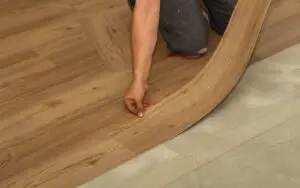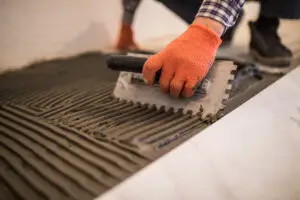Understanding Wood Floor Refinishing
What is Sanding Wood Floors?
Process and Tools
Sanding wood floors is a mechanical process that uses abrasive materials to remove the top layer of the wood, including the old finish, stains, and any minor imperfections. This process typically involves using various grades of sandpaper, and specialized equipment like drum sanders, orbital sanders, and edge sanders. The sanding process must be done meticulously, using the correct techniques to avoid damaging the wood. Professional installers are highly skilled in the art of sanding wood floors.
Benefits of Sanding
The main benefit of sanding is its ability to create a smooth, even surface that is ideal for a new stain or finish. Sanding also removes deep scratches, embedded dirt, and any other imperfections that may be present. It is also one of the most efficient methods for refinishing hardwood floors, and is often the preferred method for most flooring projects.
What is Stripping Wood Floors?
Process and Materials
Stripping wood floors is a chemical process that uses specialized solvents and removers to dissolve the existing finish. Unlike sanding, stripping does not remove any wood fibers, and can be beneficial in certain situations. The process involves applying a chemical stripper to the floor, letting it sit for the specified time, and then using a scraper to remove the old finish. It is essential to use proper safety precautions when handling these chemicals, and ensure that the area has proper ventilation.
Benefits of Stripping
Stripping can be advantageous when dealing with very old floors that have multiple layers of finishes, or when you want to preserve the original character of the wood. It’s also a good option when working with intricate designs or detailed inlays that could be damaged by sanding, or when sanding is simply not desired. These are all benefits of stripping that professional installers will often consider.
Comparing Sanding and Stripping
Effectiveness in Removing Finishes
How Each Method Performs
Sanding is generally more effective at removing thick layers of finish and leveling the wood surface. However, stripping is more effective at removing very old and stubborn finishes. The method used often depends on the age and condition of the floor, and is a choice that is best left for a professional installer.
When Stripping is More Effective
Stripping is often preferred for very old floors, or when the existing finish is particularly difficult to remove by other means. It’s also the preferred method when you want to avoid removing any wood fiber, or when dealing with delicate floors that could be damaged by sanding. Professional installers are very familiar with all of the situations when stripping is preferred.
Impact on Wood
How Each Method Affects the Wood
Sanding removes a small amount of wood fiber, which is necessary to create a smooth surface. However, aggressive sanding can damage the wood, if not done correctly. Stripping, on the other hand, does not remove any wood fiber, but the chemical stripper can be harmful if not used correctly, or if safety precautions are not taken. Professional installers know how to perform both of these methods correctly, without any damage or safety concerns.
Risk of Damage
The risk of damage is higher with DIY sanding, due to the inexperience of most homeowners. It is easy to over-sand the floors, creating an uneven surface, or gouging the wood. Stripping also comes with risks when done improperly, due to the exposure to harmful chemicals and the possibility of damaging the wood, if the chemicals are not used correctly. Because of these risks, it is usually recommended to hire a professional for either method.
Time and Labor Considerations
Installation Process
Sanding is often a quicker process than stripping, as it does not require waiting for chemicals to work. However, it requires more skill and physical effort to operate the sanding equipment correctly. Stripping, while often faster on the initial preparation, may require several applications and more time for cleanup. Professional installers are familiar with both methods, and can complete them quickly and efficiently, regardless of the method chosen.
Time and Effort
Both stripping and sanding require a significant time and labor investment. DIY refinishing projects often take longer than anticipated and can be more challenging than expected. Professional installers have the knowledge, experience, and tools to complete your project much more quickly and efficiently, while also ensuring the highest quality results.
Advantages and Disadvantages of Each Method
Pros and Cons of Sanding
Best Uses
Sanding is the best method for most hardwood floor refinishing projects, and is especially well suited for removing heavy finishes, leveling floors, and preparing them for a new coat of stain or finish. Sanding is also preferred when no special considerations are needed, and the overall goal is to create a beautiful, and durable floor.
Challenges
The challenges of sanding include the potential for damage if not done correctly, the requirement of specialized equipment, and the creation of a large amount of dust. Because of these challenges, it is always recommended to hire a professional installer to perform this type of job, as it can quickly become much more complex than anticipated.
Pros and Cons of Stripping
Best Uses
Stripping is best used for very old floors, delicate floors, or when the existing finish is extremely stubborn and difficult to remove. It is also a preferred method when you are attempting to preserve the original character of the wood, or when sanding is not desired. Professional installers will assess all of these factors when helping you make your choice.
Challenges
The challenges with stripping include the use of chemicals, the possibility of not fully removing all of the finish, and the time and effort needed for proper cleanup. It is also very important to take proper safety precautions with these chemicals, and use all of the recommended safety gear. Because of these potential problems, it is usually best to leave stripping to a professional.
DIY vs Professional Wood Floor Refinishing
Challenges of DIY Refinishing
Potential for Damage
DIY attempts to refinish wood floors, either by stripping or sanding, can easily lead to damage to the wood. It is very common to over-sand floors, or damage them by using the wrong chemicals, or not taking the proper safety precautions. These types of errors are easily avoided when hiring a professional installer.
Inconsistent Results
Achieving consistent and professional-looking results is difficult for most DIYers. Uneven sanding, incomplete stripping, or improper finish application are very common problems that will reduce the value and lifespan of your floors. Professional installers are highly skilled at avoiding all of these issues.
Tool Requirements
Both sanding and stripping methods require specialized tools that are often expensive to rent or purchase, including sanders, scrapers, chemicals, safety gear, and dust collection systems. Most homeowners do not have access to these types of equipment, or the knowledge of how to use them properly, which makes a DIY refinishing project much more difficult than anticipated.
Benefits of Professional Refinishing
Expertise and Precision
Professional wood floor refinishing services provide expertise and precision. They are well-trained in all of the techniques required for both sanding and stripping, and they have the knowledge to choose the best method for each situation. Their skills, and experience, makes sure the end result is always flawless.
Access to Professional Equipment
Professional installers have access to high-quality, industrial grade equipment and materials that are not readily available to most homeowners. This type of equipment is more powerful, efficient, and will always provide the best and highest quality results.
Long-Term Value
While professional wood floor refinishing might have a higher upfront cost, it often provides better long-term value by preventing costly mistakes and ensuring a durable, long-lasting finish. Professional installers also provide a warranty, which protects you from any issues and provides complete peace of mind.
Case Studies: Stripped vs. Sanded Floors
Example of Poor DIY Stripping
A homeowner attempted a DIY wood floor stripping project, hoping to save money on labor costs. However, they used the wrong chemicals, and did not use all of the necessary safety gear. They ended up damaging the wood, and were not able to completely remove the old finish. They also had issues with proper ventilation, and had a very hard time cleaning up. The result was an unprofessional looking floor, and the homeowner then had to hire a professional to correct all of their mistakes, costing them more than if they had hired the professional to begin with.
Example of a Successful Professional Sanding Job
Another homeowner hired a professional wood floor refinishing service for their old hardwood floors. The professional installer used the correct tools, and techniques, to sand the floor perfectly. The new stain and finish was applied evenly and consistently, resulting in a beautiful and durable floor that the homeowner was extremely happy with.
FAQs & Answers
The primary difference between stripping and sanding wood floors is that sanding uses abrasive materials to remove the old finish and smooth the wood, while stripping uses chemical solvents to dissolve the old finish without removing any wood fibers. Both methods aim to prepare the floors for a new finish, but they have unique pros and cons. Professional refinishing experts can assess your floors and choose the best approach for the specific needs of your home.
Stripping is often preferred when dealing with very old floors that have multiple layers of finishes, or when there are intricate details that sanding may damage, or when you would prefer to avoid sanding. Stripping is also better to use when you are attempting to preserve the original character of the wood. Professional installers have the knowledge and experience needed to determine when stripping is the preferred method.
DIY attempts to strip or sand wood floors come with significant risks, including damaging the wood, creating an uneven surface, or exposure to dangerous chemicals. Proper technique and equipment are crucial for achieving a good result. Professional installers have the skills and equipment to safely and effectively strip and sand any wood floors, while avoiding all of the potential pitfalls of DIY methods.
Professional wood floor refinishing services use high-quality equipment, such as industrial-grade sanders, chemical strippers, and specialized tools for detailed work. They are also trained in precise techniques for safe, and effective refinishing, and they have the knowledge to select the correct method and materials for your specific project, and type of flooring. They also use specialized safety gear and methods, to ensure that your floors are refinished correctly, and without any health or safety risks.
Professional wood floor refinishing services provide a high-quality, smooth, and even finish that enhances the beauty and value of your home. They can remove deep scratches, old finishes, and any other imperfections, which leaves your floors looking like new. Professional installers guarantee their work, so you can rest assured that your floors are going to look great for years to come.





